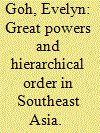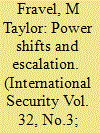|
|
|
Sort Order |
|
|
|
Items / Page
|
|
|
|
|
|
|
| Srl | Item |
| 1 |
ID:
080672


|
|
|
|
|
| Publication |
2007.
|
| Summary/Abstract |
Why has the United States, with its long-standing Liberal tradition, come to embrace the illiberal policies it has in recent years? The conventional wisdom is that al-Qaida's attacks on the United States on September 11, 2001, and the subsequent war on terrorism have made America less Liberal. The logic of this argument is straightforward: interstate war has historically undermined domestic liberties, and the war on terrorism is causing the United States to follow this well-worn path. This explanation confronts a puzzle, however: illiberal U.S. policies-including the pursuit of global hegemony, launching of a preventive war, imposition of restrictions on civil liberties in the name of national security, and support for torture under certain circumstances-manifested themselves even before the September 11 terrorist attacks and were embraced across the political spectrum. Indeed, it is precisely American Liberalism that makes the United States so illiberal today. Under certain circumstances, Liberalism itself impels Americans to spread their values around the world and leads them to see the war on terrorism as a particularly deadly type of conflict that can be won only by employing illiberal tactics
|
|
|
|
|
|
|
|
|
|
|
|
|
|
|
|
| 2 |
ID:
080676


|
|
|
|
|
| Publication |
2007.
|
| Summary/Abstract |
In response to the perceived inability of the Indian military to leverage its conventional superiority to end Pakistan's "proxy war" in Kashmir, the Indian Army announced a new offensive doctrine in 2004 intended to allow it to mobilize quickly and undertake limited retaliatory attacks on its neighbor, without crossing Pakistan's nuclear threshold. This Cold Start doctrine marks a break with the fundamentally defensive military doctrines that India has employed since gaining independence in 1947. Requiring combined arms operating jointly with the Indian Air Force, Cold Start represents a significant advance in India's conventional military capabilities. Yet, despite the Indian Army's intentions, it risks provoking or escalating a crisis on the subcontinent that could breach the nuclear threshold. Recent military exercises and associated organizational changes indicate that although the Indian Army has made progress toward developing an operational Cold Start capability, particularly in the area of network-centric warfare, the doctrine remains in the experimental stage. Nevertheless, this is a development that deserves further study. As the Indian Army enhances its ability to achieve a quick military decision against Pakistan, the political pressure to employ such a strategy in a crisis will increase-with potentially catastrophic results.
|
|
|
|
|
|
|
|
|
|
|
|
|
|
|
|
| 3 |
ID:
080675


|
|
|
|
|
| Publication |
2007.
|
| Summary/Abstract |
The small and medium-sized states in Southeast Asia have faced significant geostrategic changes with the end of the Cold War and the rise of China. Over the last decade, scholars have debated how these countries would cope with growing Chinese power, and how their relations with the other major powers in the region would change. Some analysts have suggested that the region is shifting toward a more China-centered order, but this view is premature. Eschewing the simple dichotomy of balancing versus bandwagoning, Southeast Asian countries do not want to choose between the two major powers, the United States and China. This avoidance strategy is not merely tactical or time-buying; instead, Southeast Asian states have actively tried to influence the shape of the new regional order. Key Southeast Asian states are pursuing two main pathways to order in the region: the "omni-enmeshment" of major powers and complex balance of influence. They have helped to produce an interim power distribution outcome, which is a hierarchical regional order that retains the United States' dominant superpower position while incorporating China in a regional great power position just below that of the United States.
|
|
|
|
|
|
|
|
|
|
|
|
|
|
|
|
| 4 |
ID:
080674


|
|
|
|
|
| Publication |
2008.
|
| Summary/Abstract |
Japanese leaders struggled for decades to overcome legal, political, and normative constraints on the expansion of the Self-Defense Forces so that Japan could field a robust military. Their progress was steady and significant, but slow. Now, having reframed the nature of the threat Japan faces and having borrowed creatively from the U.S. model, they have found new traction by empowering the Japan Coast Guard (JCG). Today's JCG has what its publicists, citing capabilities explicitly banned by Japan's constitution, call "New Fighting Power!" Remarkably, however, JCG modernization and expansion are being achieved without much objection from Japan's neighbors or from the domestic public. Although the JCG is not a "second navy," it is already a fourth branch of the Japanese military. Tokyo is now able to project additional diplomatic influence as well as "fighting power." Japan's "new fighting power" is thus greater than the sum of its military parts.
|
|
|
|
|
|
|
|
|
|
|
|
|
|
|
|
| 5 |
ID:
080673


|
|
|
|
|
| Publication |
2008.
|
| Summary/Abstract |
Although China has been involved in twenty-three territorial disputes with its neighbors since 1949, it has used force in only six of them. The strength of a state's territorial claim, defined as its bargaining power in a dispute, offers one explanation for why and when states escalate territorial disputes to high levels of violence. This bargaining power depends on the amount of contested land that each side controls and on the military power that can be projected over the entire area under dispute. When a state's bargaining power declines relative to that of its adversary, its leaders become more pessimistic about achieving their territorial goals and face strong preventive motivations to seize disputed land or signal resolve through the use of force. Cross-sectional analysis and longitudinal case studies demonstrate that such negative shifts in bargaining power explain the majority of China's uses of force in its territorial disputes.
|
|
|
|
|
|
|
|
|
|
|
|
|
|
|
|
|
|
|
|
|